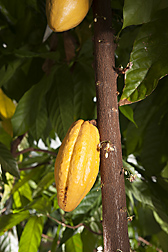| January 2012 |
USDA Research Explores Mineral Content of Broccoli VarietiesAgricultural Research Service (ARS) findings published recently in the journal Crop Science showed no evidence for significant increases or declines in mineral levels in new varieties of broccoli since 1975, and the broccoli contains similar levels of calcium, copper, iron, magnesium, potassium and other minerals that have made the vegetable a healthy staple of American diets for decades. The ARS studies found no proof of changes in terms of mineral content in the past 35 years in a crop that has undergone significant improvement from a quality standpoint and that was not widely consumed in the United States before the 1960s. For details, contact: Mark Farnham, (843) 402-5300, ext. 5327, ARS U.S. Vegetable Laboratory, Charleston, S.C. |
|
|
|
Nutrient Data In Time for the New YearTwo new nutrient data sets provided by Agricultural Research Service (ARS) scientists are available to the beef and pork industries to provide new Nutrition Facts labels for their products. Although some retailers already have begun conforming to the new federal rules, the starting date for implementation of the rules requiring specific meat and poultry products to carry nutrition information has been extended from January 1 to March 1. USDA's Food Safety and Inspection Service (FSIS) announced that the new rules will make important nutrition information readily available to consumers for 40 of the most popular cuts of meat and poultry. For details, contact: Joanne Holden, (301) 504-0630, Nutrient Data Laboratory, ARS Beltsville Agricultural Research Center, Beltsville, MD. |
Soy Milk vs. Cow's Milk vs. Mothers MilkScientists are taking a close look at the effects that soy-based formula, cow's-milk formula, and mother's milk have on bone development in infants. Very little is known about the short- and long-term effects of soy formula on bone health, but a series of studies funded by the Agricultural Research Service (ARS) is helping to fill in the knowledge gap. One early investigation provided a comprehensive comparison of bone formation in piglets that were fed either sow's milk, or soy or cow's-milk formula. The scientists chose pigs as the animal model because the pig digestive system is generally regarded as being closest to that of humans. In general, the work suggests that soy-formula-fed piglets may have the best quality bone, and that soy may enhance bone formation by directly affecting the BMP2 (short for "bone morphogenesis protein") signaling pathway. Signaling, or messaging, initiated by BMP2 is essential for building and reforming of bone. This study was the first to spotlight soy's relative influence on initiating BMP2 signaling. For details, contact: Jin-Ran Chen, (501) 364-2707, ARS Arkansas Children's Nutrition Center, Little Rock, Ark. |
|
|
|
Which Wheats Make the Best Whole-Grain Cookie Doughs?Research from Agricultural Research Service (ARS) scientists may help plant breeders zero in on promising new wheat plants that might be tomorrow's superstar producers of whole-grain soft wheat flours for cookie doughs. New, detailed evidence confirms that two inexpensive, readily available and relatively simple tests are reliable tools for getting an early in-the-laboratory indication of how good a promising new wheat may prove to be as a future source of whole-grain cookie flour. The two procedures—the sucrose SRC (solvent retention capacity) test and the milling softness equivalent test—aren't new. But this was the most thorough examination of the tests' reliability as an early screen for a new soft-wheat flour's performance in whole-grain cookie doughs. For details, contact: Margaret Redinbaugh, (330) 263-3965, ARS Soft Wheat Quality Research Laboratory, Wooster, Ohio. |
Cacao Collection Expedition May Yield Weapons for Combating Witches' Broom DiseaseFungi found in the leaves and trunks of wild Peruvian cacao trees offer the potential for biological control of cacao diseases such as witches' broom disease. Several of the fungal species were previously unknown to science. Agricultural Research Service (ARS) scientists and their Peruvian collaborators conducted cacao collection expeditions in 2008 and 2009 through the Amazon Basin of Peru. The Peruvian Amazon is the heart of the center of diversity for cacao and holds great potential for finding undiscovered cacao and fungal species. The researchers are studying 342 cacao specimens collected from 12 watersheds and are categorizing the DNA of the specimens. For details, contact: Lyndel Meinhardt, (301) 504-1995, ARS Sustainable Perennial Crops Laboratory, Beltsville, Md.. |
|
|
|
Cleaning Cows From The Inside OutAgricultural Research Service (ARS) scientists and their collaborators have conducted a series of studies to explore non-antibiotic methods to reduce foodborne pathogens that are found in the gut of food animals. Early data showed the feasibility of using orange pulp as a feed source to provide anti-pathogenic activity in cattle. Consumption of citrus byproducts (orange peel and pulp) by cattle was also shown to be compatible with current production practices, and the byproducts are palatable to the animals. For one study, the team fed dried orange peel pellets to sheep as a model for cows for eight days. They found a tenfold reduction in Salmonella populations in the animals' intestinal contents. For details, contact: Todd Callaway, (979) 260-9374, ARS Food and Feed Safety Research Unit, College Station, Texas. |
Food Safety Scientist Named to ARS Science Hall of FameZoologist Ronald Fayer, who works in the Agricultural Research Service (ARS) Environmental Microbial and Food Safety Laboratory in Beltsville, Md., has been inducted into the ARS Science Hall of Fame. Fayer was recognized for his scientific research leadership on parasites that infect animals and humans, particularly pathogens affecting food animals and food safety. He has led a broad range of work on parasite identification and host-parasite relationships, and his work has resulted in significant innovations on parasite controls that have helped secure food safety and food supplies around the world. Results from Fayer's findings have been widely adopted by pharmaceutical researchers, epidemiologists, veterinarians and other health professionals who track and control parasite infestations and foodborne illness. For details, contact: Ronald Fayer, ARS Environmental Microbial and Food Safety Laboratory, Beltsville, Md. |
|








